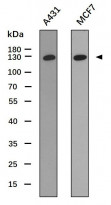ARG66480
anti-Cadherin (pan) antibody
anti-Cadherin (pan) antibody for IHC-Formalin-fixed paraffin-embedded sections,Western blot and Human
EMT Study antibody; Epithelial Marker antibody
Overview
| Product Description | Mouse Monoclonal antibody recognizes Cadherin (pan) |
|---|---|
| Tested Reactivity | Hu |
| Tested Application | IHC-P, WB |
| Host | Mouse |
| Clonality | Monoclonal |
| Isotype | IgG1, kappa |
| Target Name | Cadherin (pan) |
| Antigen Species | Human |
| Immunogen | Synthetic peptide derived from Human Cadherin (pan). |
| Conjugation | Un-conjugated |
| Alternate Names | Uvomorulin; Arc-1; Cadherin-1; E-cadherin; CDHE; CD antigen CD324; ECAD; CAM 120/80; LCAM; Epithelial cadherin; UVO; CD324 |
Application Instructions
| Application Suggestion |
|
||||||
|---|---|---|---|---|---|---|---|
| Application Note | IHC-P: Antigen Retrieval: Citrate buffer (pH 6.0) was used. * The dilutions indicate recommended starting dilutions and the optimal dilutions or concentrations should be determined by the scientist. |
||||||
| Observed Size | ~ 130 kDa |
Properties
| Form | Liquid |
|---|---|
| Purification | Affinity purification with immunogen. |
| Buffer | PBS, 0.02% Sodium azide, 50% Glycerol and 0.5% BSA. |
| Preservative | 0.02% Sodium azide |
| Stabilizer | 50% Glycerol and 0.5% BSA |
| Concentration | 1 mg/ml |
| Storage Instruction | For continuous use, store undiluted antibody at 2-8°C for up to a week. For long-term storage, aliquot and store at -20°C. Storage in frost free freezers is not recommended. Avoid repeated freeze/thaw cycles. Suggest spin the vial prior to opening. The antibody solution should be gently mixed before use. |
| Note | For laboratory research only, not for drug, diagnostic or other use. |
Bioinformation
| Database Links | |
|---|---|
| Gene Symbol | CDH1 |
| Gene Full Name | cadherin 1, type 1 |
| Background | This gene is a classical cadherin from the cadherin superfamily. The encoded protein is a calcium dependent cell-cell adhesion glycoprotein comprised of five extracellular cadherin repeats, a transmembrane region and a highly conserved cytoplasmic tail. Mutations in this gene are correlated with gastric, breast, colorectal, thyroid and ovarian cancer. Loss of function is thought to contribute to progression in cancer by increasing proliferation, invasion, and/or metastasis. The ectodomain of this protein mediates bacterial adhesion to mammalian cells and the cytoplasmic domain is required for internalization. Identified transcript variants arise from mutation at consensus splice sites. [provided by RefSeq, Jul 2008] |
| Function | Cadherins are calcium-dependent cell adhesion proteins. They preferentially interact with themselves in a homophilic manner in connecting cells; cadherins may thus contribute to the sorting of heterogeneous cell types. CDH1 is involved in mechanisms regulating cell-cell adhesions, mobility and proliferation of epithelial cells. Has a potent invasive suppressor role. It is a ligand for integrin alpha-E/beta-7. E-Cad/CTF2 promotes non-amyloidogenic degradation of Abeta precursors. Has a strong inhibitory effect on APP C99 and C83 production. [UniProt] |
| Cellular Localization | Cell junction. Cell membrane; Single-pass type I membrane protein. Endosome. Golgi apparatus, trans-Golgi network. Note=Colocalizes with DLGAP5 at sites of cell-cell contact in intestinal epithelial cells. Anchored to actin microfilaments through association with alpha, beta and gamma catenin. Sequential proteolysis induced by apoptosis or calcium influx, results in translocation from sites of cell-cell contact to the cytoplasm. [UniProt] |
| Research Area | EMT Study antibody; Epithelial Marker antibody |
| Calculated MW | 97 kDa |
| PTM | During apoptosis or with calcium influx, cleaved by a membrane-bound metalloproteinase (ADAM10), PS1/gamma-secretase and caspase-3 to produce fragments of about 38 kDa (E-CAD/CTF1), 33 kDa (E-CAD/CTF2) and 29 kDa (E-CAD/CTF3), respectively. Processing by the metalloproteinase, induced by calcium influx, causes disruption of cell-cell adhesion and the subsequent release of beta-catenin into the cytoplasm. The residual membrane-tethered cleavage product is rapidly degraded via an intracellular proteolytic pathway. Cleavage by caspase-3 releases the cytoplasmic tail resulting in disintegration of the actin microfilament system. The gamma-secretase-mediated cleavage promotes disassembly of adherens junctions. N-glycosylation at Asn-637 is essential for expression, folding and trafficking. Ubiquitinated by a SCF complex containing SKP2, which requires prior phosphorylation by CK1/CSNK1A1. Ubiquitinated by CBLL1/HAKAI, requires prior phosphorylation at Tyr-754. [UniProt] |
Images (3) Click the Picture to Zoom In
-
ARG66480 anti-Cadherin (pan) antibody IHC-P image
Immunohistochemistry: Paraffin-embedded Human breast carcinoma stained with ARG66480 anti-Cadherin (pan) antibody at 1:200 (4°C, overnight). Antigen Retrieval: Citrate buffer (pH 6.0) was used.
-
ARG66480 anti-Cadherin (pan) antibody WB image
Western blot: 30 µg of A431 and MCF7 whole cell lysates stained with ARG66480 anti-Cadherin (pan) antibody at 1:1000 dilution.
-
ARG66480 anti-Cadherin (pan) antibody IHC-P image
Immunohistochemistry: Paraffin-embedded Human colon carcinoma stained with ARG66480 anti-Cadherin (pan) antibody at 1:200 (4°C, overnight). Antigen Retrieval: Citrate buffer (pH 6.0) was used.








